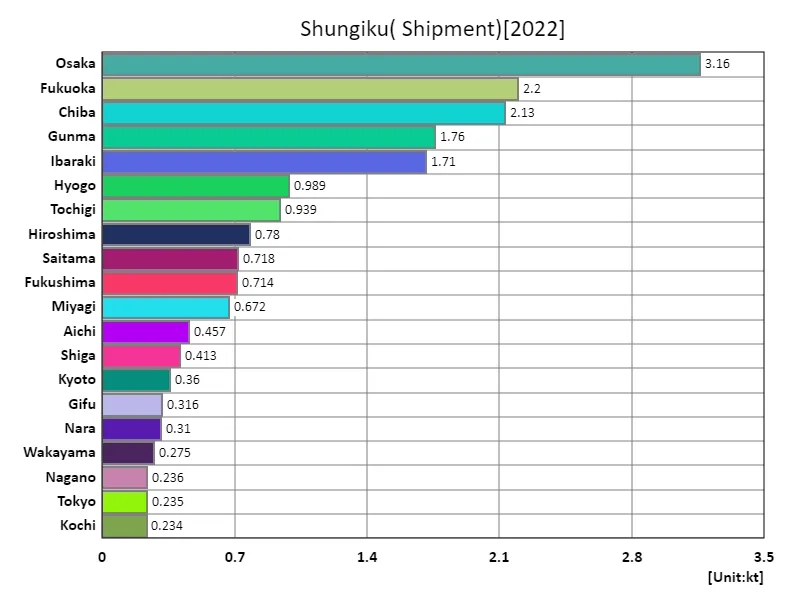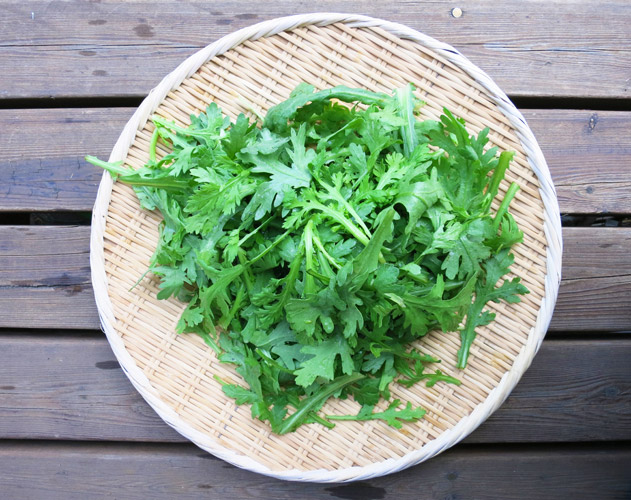Abstract
In Japan’s chrysanthemum agriculture, based on data from 2022, the national harvest volume is the largest at 26kt, and the cultivated area is the largest in the country at 1.73kha. In terms of shipping volume, Osaka has the largest volume at 3.16kt. The trend seen from these figures shows that chrysanthemum cultivation is widespread, but Osaka stands out in terms of production volume. In addition, since the harvest volume is large compared to the cultivated area, production efficiency is likely to be high. Additionally, the fact that Osaka has the largest shipping volume could suggest high demand in the area or easy access to the market. Garland chrysanthemum farming is widely practiced throughout the country, suggesting that there are differences in characteristics and demand from region to region.
Garland chrysanthemum harvest yield (main data).
Looking at the data on chrysanthemum harvest volumes from 2002 to 2022, the highest harvest volume was recorded nationwide in 2002, and has since been on a downward trend. Current yields are 60.6% of their peak, indicating a decline over the past 20 years. This may be due to a variety of factors affecting the demand for and production status of chrysanthemums. For example, possible factors include changes in demand for other vegetables and food ingredients, the impact of changing climatic conditions, and increased productivity due to advances in agricultural technology. It could also be that reduced demand or changes in agricultural policies are contributing factors. These trends suggest issues and strategies that should be considered in future chrysanthemum production.


The maximum is 42.9kt[2002] of Japan, and the current value is about 60.6%
Garland chrysanthemum harvest volume (by prefecture).
Looking at the data for leafy vegetable harvests in Japan in 2022, the overall highest is Osaka at 3.33kt, which is the current maximum value. This data shows that Osaka stands out among other prefectures in leafy vegetable production. Osaka achieves high yields due to factors such as climatic conditions and advanced agricultural technology. Also, compared to other prefectures, Osaka may be placing particular emphasis on leafy vegetable production. This trend indicates differences in agricultural characteristics and demand from region to region, and suggests that Osaka is one of the major producing areas for leafy vegetables. In the future, agriculture in Osaka and other areas will need strategies to increase leafy vegetable production and respond to changes in demand.


The maximum is 3.33kt of Osaka, the average is 553t, and the total is 26kt
Area of cultivated chrysanthemums (main data).
Looking at data from 2002 to 2022 on the area planted with chrysanthemums in Japan, the largest area was recorded in the country in 2004, and has since been on a downward trend. The current cultivated area is 67.1% of the peak area, indicating that it has been decreasing over the past 20 years. This may be due to a variety of factors affecting the demand for and production status of chrysanthemums. For example, possible impacts include changes in demand for other vegetables or crops, changes in agricultural land use, and changes in climatic conditions. Changes in agricultural policies and changing market conditions may also be playing a role. These trends suggest issues and strategies that should be considered in future chrysanthemum cultivation.


The maximum is 2.58kha[2004] of Japan, and the current value is about 67.1%
Area cultivated with chrysanthemums (by prefecture).
Looking at the data for the area of planted leafy vegetables in Japan for 2022, the largest overall is Osaka at 184 hectares, which is the current maximum value. This data shows that Osaka stands out among other prefectures in the cultivation of leafy vegetables. Osaka is attracting attention as a region capable of large-scale cultivation due to factors such as suitable climatic conditions and advanced agricultural technology. Also, compared to other prefectures, Osaka may be placing particular emphasis on cultivating leafy vegetables. This trend indicates differences in agricultural characteristics and demand from region to region, and suggests that Osaka is one of the major producing areas for leafy vegetables. In the future, agriculture in Osaka and other areas will need strategies to respond to the expansion of cultivated areas of leafy vegetable crops and changes in demand.


The maximum is 184ha of Osaka, the average is 36.7ha, and the total is 1.73kha
Garland chrysanthemum shipping volume.
Looking at the data for shungiku shipments in Japan in 2022, the highest overall was Osaka at 3.16kt, with an average of 459t and a total of 21.6kt. This data shows that Osaka leads other regions in terms of chrysanthemum shipping volume. Osaka enjoys high shipping volumes due to factors such as market access and high demand. However, the relatively low average shipping volume may explain the wide variation in shipping volumes in other regions. This is thought to reflect differences in agricultural characteristics and demand from region to region. Additionally, the total shipment volume of 21.6kt suggests that there is a certain amount of demand for chrysanthemums, although past trends suggest that demand may fluctuate. Such data suggest that it is important to consider strategies to address regional agricultural differences and fluctuations in demand.


The maximum is 3.16kt of Osaka, the average is 459t, and the total is 21.6kt



Comments